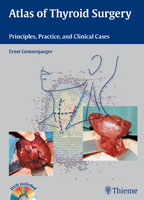Part 1
Surgical Anatomy and Surgical Technique _ 1
1 Notes on Positioning the Patient _ 2
2 Basic Surgical Anatomy _ 3
3 Incisions; Thyroid Exposure _ 4
3.1 Skin and Platysma _ 4
3.2 Transverse Division of the Superficial Fascia
and Middle Fascia _ 4
3.3 Longitudinal Median Division of the Superficial
Fascia and Middle Fascia _ 6
3.4 Modifications _ 7
4 Capsular Dissection _ 9
4.1 Anatomy _ 9
4.2 Technique _ 12
4.3 Capsular Dissection at the Upper Pole _ 12
4.4 Lateral 밄ack Door?Approach _ 17
4.5 Historical Remarks on Capsular Dissection _ 22
4.6 Capsular Dissection and Modern
Technologies _ 23
4.7 Minimal-Access Thyroid Surgery _ 23
5 Thyroid Hilus: Suspensory Ligament of Berry;
Inferior (Recurrent) Laryngeal Nerve;
Parathyroids; Posterior Thyroid Process
(Tubercle of Zuckerkandl) _ 25
5.1 Anatomical Relationships between the
Structures around the Thyroid Hilus _ 25
5.2 The Nerve at Risk _ 27
5.3 Investigation of Nerve Function _ 30
5.4 Parathyroid Glands _ 31
5.5 Tubercle of Zuckerkandl
(Madelung뻓uckerkandl) _ 31
6 Further Case Records with Demonstrations
of the Technique of Capsular Dissection _ 42
6.1 Graves Disease _ 46
Part 2
Thyroid Nodules뾏odern Concepts _ 51
7 Basic Remarks _ 52
8 Proliferation, Clonality, and Autonomy of Thyroid
Lesions _ 53
8.1 Growth. Nodules Are Genetically Determined
Hyperplastic and Neoplastic Tumors _ 53
Table of Contents
8.2 Endocrine Function. Functional Autonomy. TSH
Receptor Mutations _ 54
9 Molecular Genetic Diagnosis. Gene Profiling _ 58
10 Follicular Neoplasia _ 60
10.1 Preoperative and Intraoperative Evaluation
of Nodules _ 60
10.2 Differential Diagnosis
of Follicular Neoplasia _ 62
11 Thyroid Nodules in Surgical Practice.
Strategy of Adequate Excision _ 63
11.1 Diagnoses in Thyroid Nodules
(Personal Series) _ 63
11.2 Strategy of Adequate Excision _ 63
12 Case Records: Hyperplastic and Neoplastic
Nodules; Functional Autonomy;
Follicular Thyroid Carcinoma _ 67
12.1 Hyperplastic, Adenomatous Goiter _ 67
12.2 Follicular Neoplasia: Minimally Invasive Follicular
Thyroid Carcinoma _ 69
12.3 Solitary Nodule. Diagnosis and Treatment _ 70
12.4 Risk-Group Assignment in Follicular Thyroid
Carcinoma _ 70
12.5 Treatment of Patients with Follicular Thyroid
Carcinoma _ 72
12.6 Plummer Disease and Minimally Invasive
Follicular Thyroid Carcinoma _ 73
12.7 Very Low-Risk Follicular
Thyroid Carcinoma _ 74
12.8 Widely Invasive Follicular
Thyroid Carcinoma _ 75
12.9 Plummer Disease. Mediastinal Goiter.
Acute Respiratory Distress _ 77
12.10 Long-Standing Huge Goiter with Acute
Hemorrhage and Necrosis _ 79
12.11 Plummer Disease in an Older High-Risk Patient
with Large Compressing Goiter; Transsternal
Approach _ 80
12.12 Long-Standing Huge Goiter with Widely Invasive
Follicular Thyroid Carcinoma _ 81
13 Embryological Thyroid Development and
Developmental Anomalies: Clinical Aspects _ 83
13.1 Aberrant, Ectopic or Heterotopic Thyroid
Tissues _ 83
13.2 Further Clinical Aspects. Thymus _ 83
13.3 Case Records _ 85
aus: Gemsenjaeger, Atlas of Thyroid Surgery (ISBN 9783131450319) ?2009 Georg Thieme Verlag KG
XII Table of Contents
14 Total Thyroidectomy for Benign Nodular
Goiter _ 87
14.1 Case Records. Huge Goiters _ 87
14.2 Total Thyroidectomy for Toxic
Multinodular Goiter _ 88
14.3 Surgical Morbidity _ 89
14.4 Conclusion _ 89
15 Long-Standing Solitary Nodule _ 90
15.1 Solitary Toxic Nodule (Goetsch Disease) _ 90
15.2 Solitary Nodule with Normal Thyroid
Stimulating Hormone (Cold Nodule) _ 91
15.3 Solitary Thyroid Nodule in a Personal Series
(Prospective Clinical Study) _ 92
16 Further Clinical Considerations _ 94
16.1 The Small Subclinical and Clinical Nodule _ 94
16.2 Ultrasonographic Findings Relevant for the
Thyroid Surgeon _ 95
17 Nodules in Graves Disease _ 96
17.1 Functioning and Nonfunctioning Nodules _ 96
17.2 Nuclear Scan for Differential Diagnosis _ 96
17.3 Diagnostic and Therapeutic Regimen _ 96


